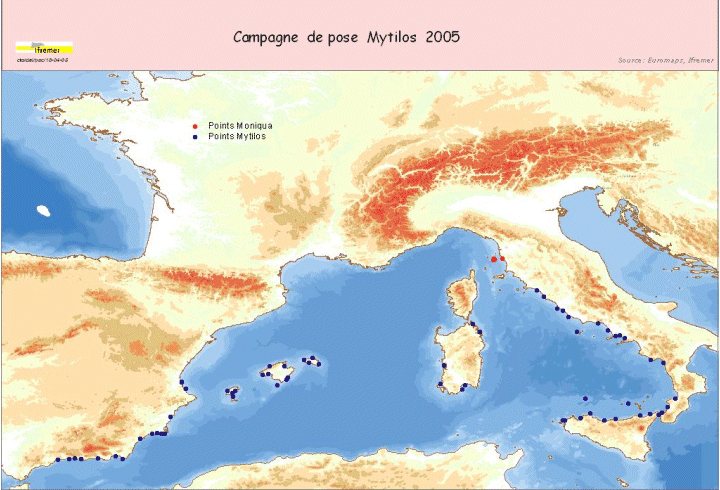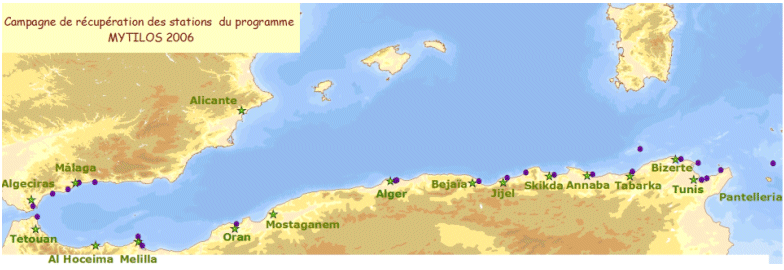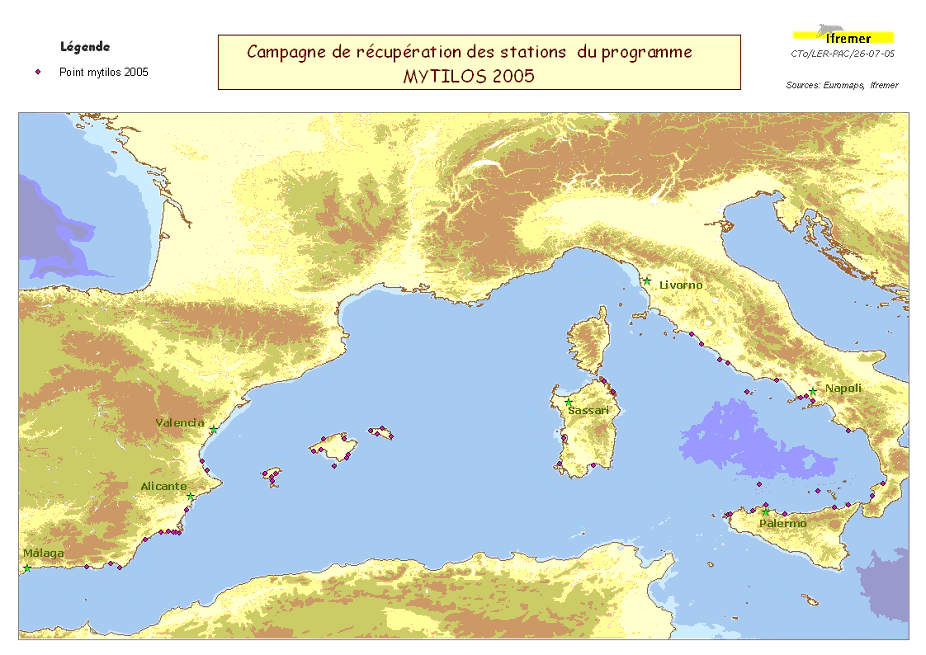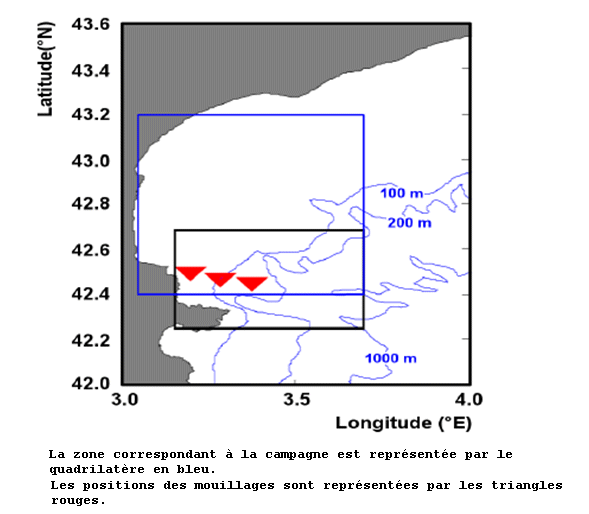Keyword
Toulon
19 record(s)
Type of resources
Categories
Topics
INSPIRE themes
Keywords
Contact for the resource
Provided by
Years
Formats
Status
-
<p style="text-align:justify">The main scientific objectives of the cruises are threefold:</p> <ul> <li style="text-align: justify;">to asses the large scale circulation in the Western Basin, evaluating the water masses and the fluxes at different key point in the basin (The North Current, The East and West Corsica currents, the Balearic front, Algerian Basin). The final goal was numerical modelling assessment.</li> <li style="text-align: justify;">to identify and follow peculiar mesoscale structures such as surface eddies, modal weddies, submesoscale coherent vortices (SCV) meanders or filaments and explore the signature on the sea surface height (altimetry) and the acoustic impact (sound propagation).</li> <li style="text-align: justify;">to observe and interpret the submesoscale dynamics such ageostrophic stirring, symmetric instabilities, mixed layer instabilities, subduction and convection.</li> </ul> <p style="text-align:justify">The <strong>Protevs2015_leg1 </strong>campaign took place from the 8th to 28th of January 2015 on board of the RV <em>Pourquoi Pas?</em> in the north western mediterranean basin. It is focused on physical aspects (hydrology and dynamics). The main objective was the dynamics of the North current from its roots in the Ligurian Sea downstream to the Gulf of Lion. The surveys try to catch not only the meso-scale features but also the submesoscale associated to the the northern current or at least in its vicinity.</p> <p style="text-align:justify"> </p> <p style="text-align:justify"> </p>
-
<p>The WESTMEDFLUX-2 oceanographic cruise is part of the project that studies the presence of thermal anomalies in the ocean-continent transitions of the Western Mediterranean. The proposed cruise follows WESTMEDFLUX that took place in 2016 and that resulted in mapping regional trends of thermicity in in the Gulf of Lion, offshore Baleares and Sardinia. It also pointed out to the existence of several local heat flow anomalies in particular on the South Balearic slope and deep basin. In the deep oceanic basin, strong anomalies seem to be merely associated to salt diapiric structures, but on the rifted continent and transition zone, other heat sink and sources are suggested (e.g., bottom water currents, slope instabilities and focused fluid migrations). In order to better understand the source of these anomalies and the link with the crustal nature and structuring of the margin, we propose on the South-Balearic margin additional close-spaced heat flow measurement, sediment coring and dredging sites. Sediment cores will be used for turbidite and contourite studies and for geochemical analysis of pore fluids. The dredging operations aim an estimation of age and nature of volcanic rock material from sea mounts.</p>
-

Assessment of chemical contamination in coastal water masses (Spain, France, Italy), using artificial stations of mussels and passive sensors. The MYTILOS 1 cruise aimed to use the RINBIO network methodology around the western Mediterranean. Experiments done in the French Mediterranean since 1996 by IFREMER will be extended to Spanish and Italian Mediterranean coasts on the basis of a standardized protocol. The data will supplement those obtained in 2004 during the RINBIOC1 cruise by including the islands of the western basin, the south of Spain and Italy. In addition, the results will be used to complement the chemical contamination budget made in the framework of the European Water Framework Directive's implementation. The survey was based on 3 major actions: 1) Artificial mussel bed stations were placed and recovered along a shoreline between Malaga (Spain) and Rome (Italy), including the Balearic Islands, Sardinia and Sicily. 2) Gellyfish-type "passive" sensor stations were deployed along with some of the artificial mussel bed stations. 3) A study was run on the site of Livorno, taking bio-integrators, Posidonia and sediment samples to assess chemical contamination levels on 3 different matrices in the framework of the MONIQUA programme. This falls under the MEDICIS project.
-

Assessment of chemical contamination in coastal water masses (Spain, Morocco, Tunisia, Sicily canal), using artificial stations of mussels. The MYTILOS1 cruise aimed to utilize the RINBIO network methodology around the western Mediterranean, in the northern part of the NW Basin. Experiments run in the French Mediterranean since 1996 by IFREMER were to be extended to Southern Mediterranean coasts, i.e. Spanish, Moroccan, Algerian and Tunisian coasts, as well as the Sicily Canal in Italy, on the basis of a standardized protocol. The data from MYTILOS2 cruise will supplement those obtained in 2004 and 2005 during the RINBIOC1 and MYTILOS1 cruises by including the coasts of North Africa, Southern Spain and the island of Pantelleria. In addition, the results will be used to complement the chemical contamination budget drawn up in the framework of the European Water Framework Directive's implementation. The survey was based on 2 major actions: 1) Artificial mussel stations were placed and recovered along a shoreline between Malaga (Spain) and Sicily (Italy), including Morocco, Algeria and Tunisia. 2) Sediment samples in addition to mussels samples were taken upon the partners' request. This falls under the MEDICIS project.
-

Assessment of chemical contamination in coastal water masses (Spain, France, Italy), using artificial stations of mussels and passive sensors. The MYTILOS 1 cruise aimed to use the RINBIO network methodology around the western Mediterranean. Experiments done in the French Mediterranean since 1996 by IFREMER will be extended to Spanish and Italian Mediterranean coasts on the basis of a standardized protocol. The data will supplement those obtained in 2004 during the RINBIOC1 cruise by including the islands of the western basin, the south of Spain and Italy. In addition, the results will be used to complement the chemical contamination budget made in the framework of the European Water Framework Directive's implementation. The survey was based on 2 major actions: 1) Retrieving artificial mussel bed stations immersed in March with R/V l'Europe along a shoreline between Malaga (Spain) and Rome (Italy), including the Balearic Islands, Sardinia and Sicily. 2) Gellyfish-type "passive" sensor stations were deployed along with some of the artificial mussel bed stations. This falls under the MYTILOS project.
-
<p style="text-align:justify">SHOM cruise with implementation of the MVP.</p>
-
SHOM cruise between Lisbon and Toulon
-
<p>MOOSE-GE aims at 1) ensuring the maintenance of offshore French Mediterranean moorings and 2) carrying out an annual mapping of hydrological, biogeochemical and biological characteristics of the whole north-western basin. The related project are MERMEX, HYMEX, MISTRALS and MOOSE.</p>
-

<p>Studying eddies related to water circulation in the Gulf of Lion. The LOPB and LOMIC labs will implement a technique never used before for coastal systems, i.e. tracking of a water mass using the chemically inert compound sulphur hexafluoride (SF6). After injecting the tracer from aboard RV Suroît, the substance's dissemination will be estimated thanks to real-time measurements performed on board. To monitor the eddy structure, RV Suroît will be accompanied by RV Tethys II. Several innovative devices or systems will be deployed simultaneously (measuring currents using Doppler acoustic profiler (with the moorings already in the zone since 2009 and the 2 vessels' shipboard current meters); Measuring surface currents using an array of HF radars installed onshore; several satellite-monitored drifting buoys, including a CARIOCA buoy which will continuously log the physical parameters and CO2 trends near the surface; autonomous underwater gliders fitted with various biogeochemical sensors; real-time satellite observation of surface temperature and phytoplankton concentrations; and operational numerical modelling. The measurements will be analyzed on board and will be used to locate the eddy's position in order to guide the vessels to the drifting research zone. The original aspect of LATEX is that it combines expertise in physical oceanography and marine biogeochemistry to try and penetrate the mystery of these mesoscale structures and particularly to assess the role they play in transfer of matter between the coastal zone and the open sea. The fate of organic matter will be closely observed during this monitoring of the drifting eddy structure to understand how the biogeochemical properties (quality of organic matter, stoichiometry of particulate matter, primary and bacterial production) evolve over time in this volume of water enclosed by physical processes.</p>
-

<p>?The cruise took place from 22 November to 20 December 2006 aboard RV L'Atalante. Its objective was to study the formation of passive continental margins and a special sedimentary sequence which exists all over the Mediterranean. The result of national (IUEM Brest, Géosciences Azur, University of Lille, UPMC) and European (Universities of Lisbon and Bologna, GEOMAR and AWI) cooperation, directed by Ifremer, the cruise mobilized some twenty scientists for nearly one month. The related project is GDR Marges.</p>
 Catálogo de datos del IEO
Catálogo de datos del IEO